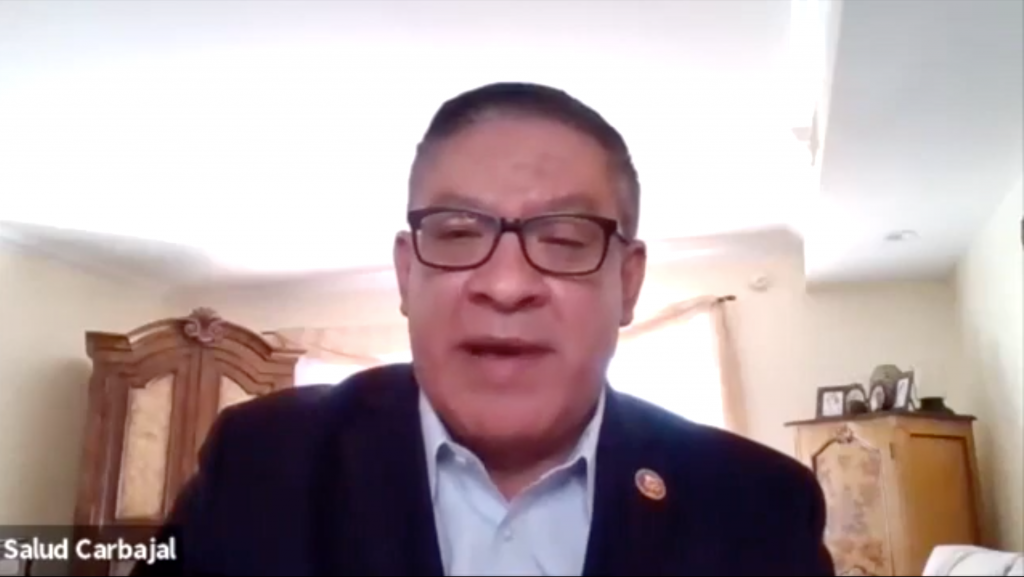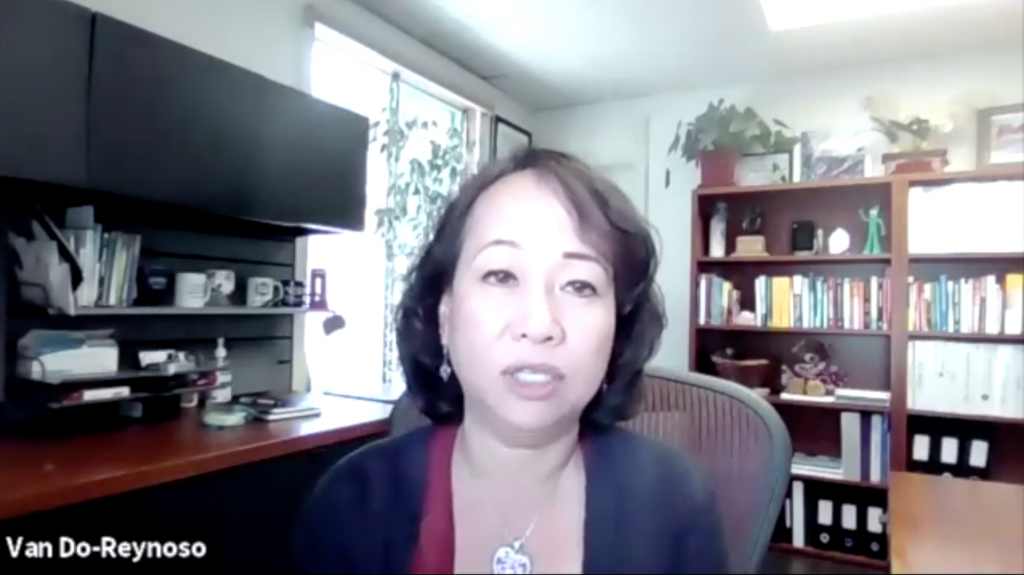Montecito Journal Hosts Town Hall Meeting with Local Officials on COVID-19 Vaccination Rollout

On February 19, the Montecito Journal hosted a mid-morning Zoom meeting during which several local politicians and health officials answered questions and addressed the challenges that have affected Santa Barbara County’s ongoing efforts to provide COVID-19 vaccinations to residents. Hosted by Editor-in-Chief Gwyn Lurie and Chief Operating Officer Tim Buckley, the meeting’s guests included U.S. Congressman Salud Carbajal; 37th Assembly District Representative Steve Bennett; County supervisors Das Williams and Gregg Hart; the County’s Public Health Director Van Do-Reynoso; and the county’s Public Health Officer Dr. Henning Ansorg.
The MJ’s Lurie began by stating the newspaper’s dedication to answering questions ranging from who exactly is eligible for vaccines to where the vaccines are being offered. She also clarified that her February 11 editorial headlined “Santa Barbara Needs a COVID Czar” was not meant as a criticism of Santa Barbara’s public health officials, but as an acknowledgement of the widespread frustration in the county about the lack of access to vaccines. As Lurie said, “The suggestion was simply that when we have an issue this pressing, sometimes it helps to bring in someone whose sole focus is to help coordinate these efforts.”
“I know it’s been rocky; it has not been easy,” Congressman Carbajal told the Zoom audience. “It’s all about supply.” Carbajal explained that despite severe shortages of vaccines, President Joe Biden’s proposed multitrillion-dollar American Rescue Plan (ARP) aims to provide more resources in order to increase the supply and speed up the distribution of vaccines. “Until we get the supply produced and then distributed to everybody, we will see these types of challenges,” he said. “I think that our local officials, under the circumstances, have been doing a heroic job.”

“It’s not over; there will be hiccups going forward,” echoed Assemblyman Bennett. “There have been eight million vaccines delivered to California, and nearly seven million have been administered.” So far, Santa Barbara County officials have delivered about 70,000 vaccines into the arms of local residents at 11 different locations, Bennett said. He added that Governor Gavin Newsom had just announced on Friday morning that his administration is focusing on educators. “He’s prioritizing teachers so that they’ll be able to get back into the classroom and we can get all the schools open again as soon as possible.”
Public Health Director Do-Reynoso began her comments by explaining the difficult choices the County has faced in trying to prioritize vaccine recipients. “It’s a daunting task,” she said. “Every group has a compelling reason why they should be prioritized and are anxious if they are not first in line or not in line at all.” Do-Reynoso attributed some of the anxiety that community members feel to misinformation about vaccine availability that has been spread on social media, blogs, and in newspapers.
“No community should have to manage the scarcity of vaccines, but here we are, unfortunately. In making the difficult choices of who gets priority, we are following State guidelines,” she said. “We simply don’t have enough, so we are forced to prioritize. With State guidance, we cautiously expanded from the 75-and-older (category) to 65-and older last week.” But now, bad weather throughout parts of the country is holding up vaccine deliveries. “We have not been receiving enough vaccines from the State to offer it to everyone who is eligible,” Do-Reynoso added.
On a positive note, Do-Reynoso stated that Santa Barbara County was just allocated 34 percent more vaccines in the past week because of its relatively high vaccination rate. “We were one of seven counties to receive an unexpected 1,170 doses yesterday, on top of our County clinics receiving 500 doses weekly. We are indeed getting our fair share of vaccines,” she concluded. “I am confident that better days are just around the corner.”

“Supply issues, that’s the big problem,” Dr. Ansorg said when it was his turn. “There were some delays in the trial period.” Whereas the Federal Government had promised to deliver 20 million doses to California by the end of December, only 12 million were shipped to the State and just three million were actually injected. “Operation Warp Speed did a fantastic job in creating these vaccines and creating a fast rollout,” said Ansorg. “But the production and distribution was delayed, unfortunately. We have to work with what we are getting… We always requested the maximum we could get from the State and have been as transparent as possible.”
For his part, Supervisor Williams said he was just as upset as anyone about the delays. “I am frustrated. Our public health staff is frustrated, and our community is frustrated because there is a supply problem,” he said. “We were only receiving 6,000 a week, which represents a little more than one percent of our population, or half that number twice. That creates frustrations.” That said, Williams stated that he believes the problem of vaccine shortages will soon be solved. “I want to tell you that things are looking good,” he said. “At the height [of the epidemic], we had about 3,500 active cases. Now, we have only about 500 cases.”
After her guests made their opening remarks, Lurie read questions that had been submitted by audience members. “Why is there a supply issue? Did we not ask for enough vaccines?” one participant wanted to know. The reader added that Santa Barbara County averaged 19,000 doses per 100,000 residents whereas Santa Cruz County’s ratio was 60,000 doses. That means that Santa Cruz County ranked eighth in the state based on the number of total shots delivered per capita versus Santa Barbara County, which ranked 31 among the 58 counties in California.
Since SB County has actually administered more total shots so far than Santa Cruz County (it’s really not much to brag about since we scored 19th overall to Santa Cruz’s 22nd place) this statistic seemed to take Dr. Ansorg off guard, enough so that he brought it up several minutes later in the Zoom call when Lurie asked why spouses of healthcare workers weren’t being given vaccines yet, despite possibly being at a higher rate of exposure to the virus.
“I can take a stab at that question,” Ansorg said. “Unfortunately, unless they are over the age of 65 or a healthcare worker… they are not in line to now get the vaccine. So my wife wasn’t able to get it either. I am sorry about that, but that is simply a fact. They are not at that high risk because they are not in direct patient contact.”
Lurie pressed on. “Just because someone is vaccinated doesn’t mean they can’t pass on whatever they’ve been exposed to,” she argued. “So in fact they are one person away, sort of exposed indirectly to the patients that their spouses are exposed to.”
“Let me rectify this, sorry,” Ansorg said. “There is no science saying that spouses who are direct family members of healthcare workers are at greater risk for catching [the virus]. You may have anecdotal stories but please show me the science and don’t just put things out there like comparing [us] to Santa Cruz County.” Ansorg then asked Lurie for the source of that figure, to which Lurie responded that it was based on information recently released by the California Department of Health and already in the public domain. (You can see these rankings here: www.latimes.com/projects/california-coronavirus-cases-tracking-outbreak/covid-19-vaccines-distribution.)
One interesting exchange occurred when Lurie read aloud a question from a reader who wanted to know why County sanitation workers weren’t being included in the same category as other high-risk front-line workers.
“Obviously, the trash has to be picked up,” Lurie pointed out. “They can’t not work, so are they being considered as at-risk people? I know Marborg workers are handling waste, porta-potties etc., for homeless people.” Lurie also referred to reports that many sanitation workers have been forced to self-quarantine because of fears of falling ill from the virus.
“I appreciate the services being provided by Marborg,” Do-Reynoso responded. “They are critical, essential workers that also need to be vaccinated. Unfortunately they are not in the three categories at the three sectors that the State is allowing right now.” The County, she said, is currently waiting for guidance from the State on when that criteria might change.”
At this point, Carbajal asked if he could chime in. “I think it’s important for the State and our governor to hear us on making sure that sanitation workers are allowed. You go for a week without your garbage being picked up, it’s not going to be healthy or good. So I think it’s important that we let our governor know that we’re a few days away from disaster when it comes to that. I would say he needs to open up, and I know it comes down to supply, but I think it’s really important to advocate for and really reexamine, to see if he can add sanitation workers.”
Perhaps the most striking moment of the town hall occurred when Do-Reynoso objected to Lurie’s use of the term “discretion” to characterize the County’s approach to vaccination. However, in elaborating her objection, Do-Reynoso essentially confirmed that, in fact, exercising a certain level of discretion is exactly what the County had been forced to do.
“I think the bottom line is we are all in agreement that everyone deserves to be vaccinated,” she explained. “Unfortunately, I want to ground us: We simply do not have enough vaccines to offer everyone and so until we get to that point, we do have to do the ‘Sophie’s Choice’ and vaccinate the most critical and the most vulnerable members of our community.”
To watch the entire video of the town hall and to see additional answers to questions, go to montecitojournal.net.
A Follow-Up Conversation About COVID-19 Rollout with County Health’s Jackie Ruiz
As underscored by the MJ’s town hall meeting on February 19, we are two months into the county’s COVID-19 vaccine rollout and confusion swirls. Who is eligible to receive a shot, and why has it taken so long to dose up eligible county residents? With that in mind, Jackie Ruiz, the County Public Health Department’s public information officer, answered more questions about the status of the County’s vaccination effort.
Q. So who exactly in Santa Barbara County is eligible to receive a COVID-19 vaccine dose as of right now?
A. As of Tuesday, February 16, residents who are 65-plus years of age are eligible to receive vaccination in the county. Healthcare workers, who are in category 1A, are still eligible; some have already received two shots, others have not. The rest of the folks in the 1B tier, which includes agricultural and food workers, teachers, and emergency services workers, are not yet eligible for vaccination in a broad sense throughout our county. However, there are pilot projects that will be underway to target some of those populations. UC Santa Barbara and the Marian Regional Medical Center have a special channel to get more vaccine than what the State provides through the Public Health Department. We are allowing them to distribute via their pilot programs beyond the 65-plus range, but they haven’t started yet.
Can you explain the delay in vaccine availability, which has led to the cancellation of appointments in clinics throughout the county?
Yes. Unfortunately, Public Health had multiple vaccine clinics planned for this week, but then received notification from the California Department of Public Health that our Moderna vaccine shipment would be delayed because of the weather. So, we don’t think we will see that shipment until next week. It’s a few thousand vaccines. We are not the only entity in the county that receives Moderna, so the impact will be broader.
How exactly did that impact the clinics last week?
We had planned [to offer vaccines in] four clinics. We were still able to have one on Tuesday in Santa Barbara. For our Wednesday clinic in Santa Maria, we were able to pull from all our resources and vaccinate 400 people, but we had to cancel about 800 shots. We had to cancel two clinics in Lompoc and Santa Barbara this week, but all of these patients received a link so they can receive shots next week.
At Public Health we partnered with a number of different pharmacies, including Vons on Coast Village Road, Albertsons in Carpinteria and Santa Maria, and the Ralphs on Carrillo Street in Santa Barbara. We have partnered with these pharmacies and are giving them vaccines so they can distribute to people in the community as well. Because of the limited quantities, it’s been limited, though. We are just not receiving enough vaccines.
How many vaccines have you been able to distribute in Santa Barbara so far?
The first date someone was vaccinated in our county was December 14, 2020. As of this past week, we have distributed a total of 60,443 shots, which is a combination of first and second doses. We update our totals every week on our website, www.countyofsb.org/phd.
There have been rumors that cannabis workers are receiving their shots ahead of teachers and other front-line workers. Is there any truth to that?
Well, it’s a little bit varied. Per State guidelines, front-line workers in the medical cannabis industry are considered healthcare workers so they are eligible to be vaccinated. But that’s just a tiny handful of people. Cannabis industry workers involved in growing, storage, transport, and distribution are considered by the State to be in the same category as the agricultural sector.
That said, when it comes to the Public Health Department, nobody from the cannabis industry has been vaccinated at our sites. Eighty percent of the allocation of vaccines that comes to Santa Barbara County is given directly to pharmacies, healthcare centers, and hospitals; we only keep 20 percent of that allocation at our sites, so while it’s possible that some cannabis workers have been vaccinated, it’s not at all a result of county policy. In any case, this guidance from the state just came in on February 13. So before this, they were not eligible and there is no way they would have been eligible before that date.
Would you say that, once the vaccines are here, Santa Barbara County is well-positioned to get these shots to as many residents as possible in a swift and efficient manner?
Absolutely. We have always said we’d distribute to those aged 75 and older first, because they are the people who face the highest mortality rates. We had a pot of 35,000 people who fall into the 75-plus category. When we reached a threshold of vaccinating 65 percent of people aged 75 and older, we felt we could start looking at vaccinating people aged 65 and above. We truly wish we could vaccinate everybody, and we have a lot of resources.
So who exactly is helping accomplish all this?
At our vaccination sites we have anywhere from 30 to over 60 County workers who have had experience running annual flu vaccine programs for many years. They run each vaccine operation.
We also have County Fire employees in the mix, helping us. In fact, just about every County department is sending resources. We also have the Medical Reserve Corps, a long-established program that is very robust and involves volunteers from throughout our community. We have a long list of community members who have volunteered. In terms of infrastructure and partnerships, we have plenty of those, too. What we don’t have yet are enough vaccines to put in the arms of people.





